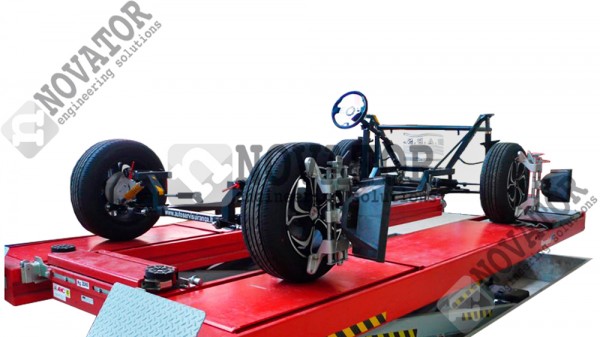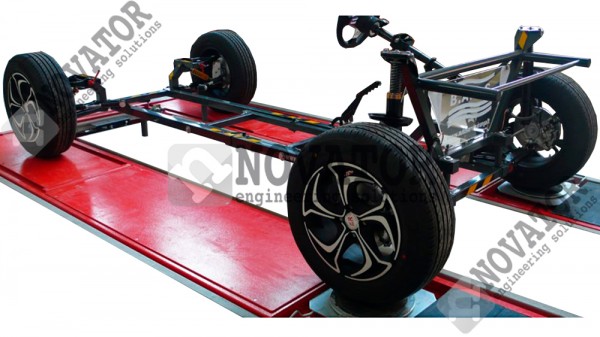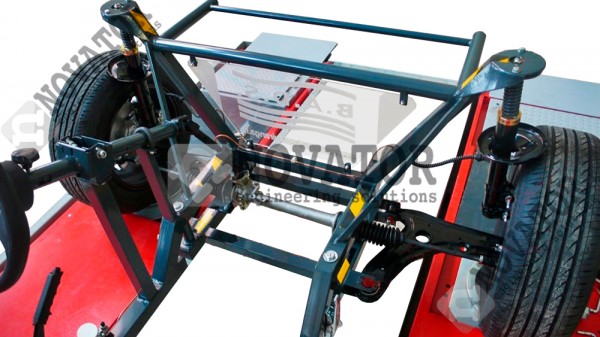Chassis training stand
|
|
|
PLANB_FULLICONS-ONE
PLANB_FULLICONS-TWO
PLANB_FULLICONS-THREE
PLANB_FULLICONS-FOUR
PLANB_FULLICONS-FIVE
? Ask a question
Description
Chassis training stand
Chassis training stand is specially designed to demonstrate the vehicle chassis structure and wheel alignment. McPherson-type front suspension and multi-link rear suspension is integrated in a training stand. Wheel alignment training stand is a great educational tool that allows students to introduce the different types of automobile chassis, study suspension components and angles modification, perform various measurements and other diagnostic procedures. Using this training stand it is very easy to teach several students at once, because all suspension components are visible from all sides. Suspension geometry adjustments are performed like in a real automobile – using screws and tools.
Technical specifications and functions
Main functions
Wheel alignment training stand consists of McPherson-type front suspension and multi-link rear suspension. McPherson-type front suspension has 8 adjustment points that allows:
- To adjust camber and caster angles by sliding shock absorber upper mount;
- To adjust camber and steering axis inclination at 4 points;
- To adjust camber and caster angles by turning front eccentric bolt on the front lever;
- To adjust caster angle by turning rear eccentric bolt on the front lever;
- To adjust toe by the steering tie rod;
- To adjust camber angle by sliding the wheel with unscrewed lower link on the front lever. Steering axis inclination is also changing;
- To adjust caster angle and automobile base by loosening the subframe and sliding it along the length. Camber angle and steering axis of the vehicle can be adjusted by sliding subframe sideways;
- Steering wheel lock bolt allows to capture the steering wheel and the steering column in order to keep the steering wheel in a stable position.
The rear multi-link suspension has 3 adjustment points, that allows to:
- To adjust caster angles (alignment) by adjusting lower rod;
- To adjust camber angles (alignment) by adjusting the eccentric bolts on the upper lever;
- To adjust the longitudinal position of the wheel by adjusting the front rod of the rear suspension.
With devices for the suspension geometry adjustment it is available for students to demonstrate these measurements and settings:
- Wheelbase distances and diagonals;
- Axis shift in relation to one another;
- Scrub radius;
- Caster trail;
- Steering axis inclination (SAI);
- Tread width;
- Wheel base length;
- Front and rear axle wheel set back;
- Ride height (zero ride height);
- Central line position;
- Traction line operation, thrust angle;
- Toe difference angle;
- Turning radius;
- Included angle.
Diagnostic and measurement
Chassis training stand is designed for measurement the angles of the suspension using all types and technology:
- 3D Technology Wheel Alignment;
- CCD Technology Wheel Alignment;
- Mechanical Wheel Alignment (Rulers, cords).
The automobile lift is not necessary for training and demonstration, because an open training construction allows to see and perform various measurements from all sides.
Chassis training stand allows to demonstrate measurements and adjustment possibilities of the suspension.
Other
- Wheel alignment training stand can be easily folded and placed so that it take up minimal space for storage and transportation.
- The front axle has a hydraulic brakes.
- The rear axle wheels are blocked by lockbolts.
Dimensions (approx. Hx LxW):
- Fully spread base 110 x 310 x 170;
- Storage 110 x 165 x 170 (stand on the wheels);
- Storage 165 x 110 x 170 (upright stand);
- Weight (netto) approx. 195 kg;
- Made in Lithuania;
- CE certificate.









